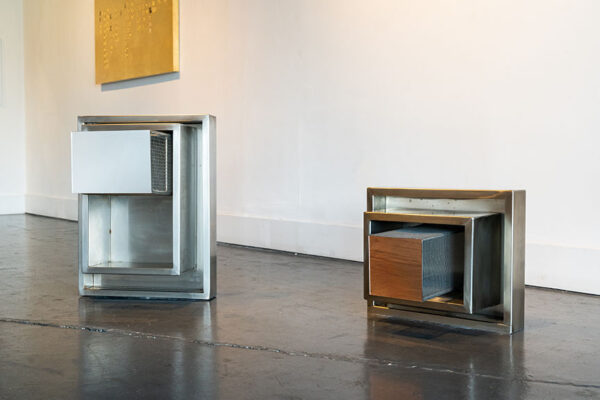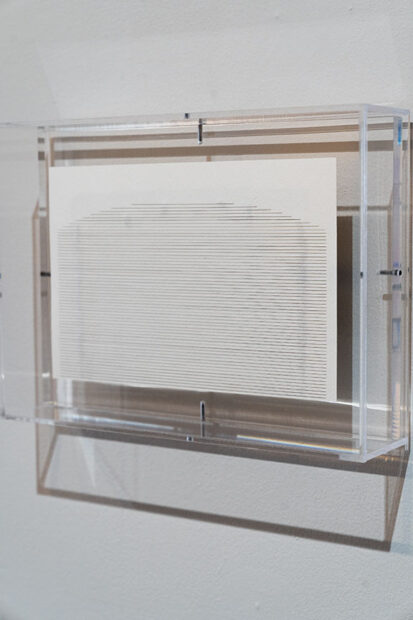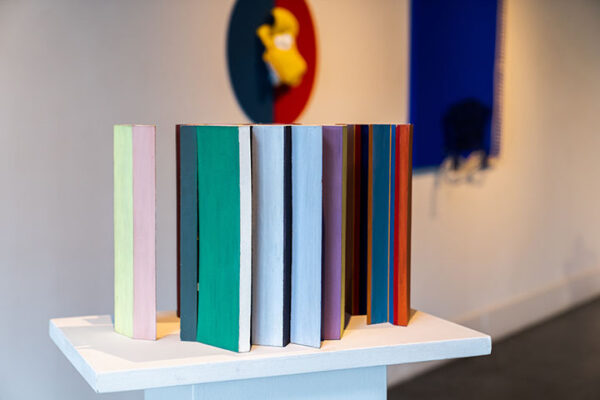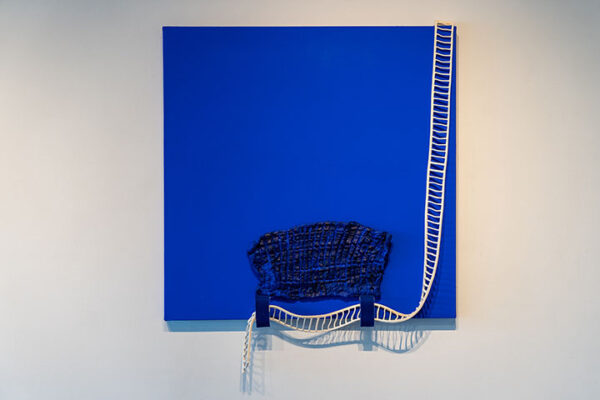Para leer este artículo en español, por favor vaya aquí. To read this article in Spanish, please go here.
To read about the New York City presentation of this exhibition, go here.

Teresa Serrano, “The Light Within” and “Inside the Being,” 1994, mirror, stainless steel, and mesh. Photo: Abraham Aguillon Orsag, courtesy of Ruiz-Healy Art.
As far as titles go, I Am Not Your Mexican is perhaps as explicit as it gets. Right off the bat we are implicated as viewers who hold implicit biases. The title speaks differently to everyone reading, but — at its baseline — it is unapologetic and unwavering in its gripping resolve.
The title of one of Jesse Amado’s series, I Am Not Your Mexican references the title of I Am Not Your Negro, a 2016 film based on the writings of James Baldwin that offers a social critique of the under-representation of Black Americans in popular history. By adapting the title of an internationally acclaimed film, viewers are pushed to pick-up on this reference point and consequently question the lack of Mexican and Mexican-American representation within the canon of art history thus far.
At Ruiz-Healy Art in San Antonio and New York, historical works (dating as far back as the 1960s) by Mathias Goeritz, Hersúa, and Teresa Serrano stand side-by-side with more recent pieces by Jesse Amado, Willy Kautz-Jippies Asquerosos, and Fernando Polidura. Curated by writer Eduardo Egea, the show combines three-dimensional abstract art objects that, at first glance, may be reminiscent of the “hollow” artworks (in the words of Michael Fried in his seminal 1967 text on Minimalism, “Art and Objecthood”) associated with the Minimalist movement.
However, some materials used in the artworks on display, such as mirrors, human hair, and chicharrón, are imbued with cultural and social meanings and references, thereby undermining the mere objecthood associated with the movement. Egea argues that the show is reminiscent of a Postminimalist tendency, a necessary departure from the inflexibility of Minimalism.
Necessary indeed, as the Western art historical narrative tends to position quite a narrow focus on New York-based artists such as Carl Andre, Dan Flavin, Donald Judd, Anne Truitt, Sol LeWitt, and Robert Morris as the standard-bearers of Minimalism. This limited scope, along with the exhibition The Art of the Real: USA 1948-1968 (which traveled to multiple countries around Europe in the late sixties and seventies), led to the USA’s identity as an artistic imperial power.

Fernando Polidura, “CF Fourteen,” 2023, human hair embroidered on cotton paper. Photo: Abraham Aguillon Orsag, courtesy of Ruiz-Healy Art.
Artworks included in I Am Not Your Mexican walk the tenuous line between art and life and astutely manipulate geometry, line, and seriality to emphasize their handmade nature. Human hair is delicately and laboriously embroidered onto cotton paper in straight horizontal lines that exhibit an impeccable sharpness in two works by artist Fernando Polidura. The linework in CF Fourteen maintains equal margin spacing and generates a robust rectangular shape until near the top of the page, where the lines begin to decrease in length. Like that of a receding perspective, the top eight lines steadily creep up and diagonally inward, resulting in a box-like shape with illusory three-dimensional depth. CF Fourteen is almost mechanically precise in its exactness and simultaneously preserves order and fragility in its use of human hair, craftsmanship, and perspective — Polidura created this series during the SARS-COV-2 pandemic as a way of refocusing a desire for control caused by his obsessive-compulsive disorder.
While Polidura’s work triggers an intimate confrontation with his use of organic materials and bodily forms on the vertical plane (such as with Thirty-first Adjustment, which, with vinyl paint, paper, and shrink wrap film, results in a stretched and wrinkled skin-like surface), Teresa Serrano’s stainless steel objects address a viewer’s existence in the gallery space with the interplay of light, positioning, and gender-associated materials.

Installation view of “I Am Not Your Mexican” on view at Ruiz-Healy Art in San Antonio. Photo: Abraham Aguillon Orsag, courtesy of Ruiz-Healy Art.
Angled towards the entrance of the gallery are Teresa Serrano’s 1994 stainless steel, mirror, and mesh sculptures, The Light Within and Inside the Being. The Light Within stands up on the floor and has one open-faced stainless steel tray inset into another. A mesh cuboid protrudes out of the two trays and is closed-off with a rectangular mirror on its face. A growth sequence emerges as the trays, followed by the mesh, successively decrease in size and increase in depth. The mirror puts an end to the sculpture’s internal sequence and, at the same time, invites infinite external possibility.
A viewer’s height, spatial positioning, and the time of day the sculpture is viewed all impact the angle of the mirror’s reflection and the light patches and shadows that it casts around the gallery space. The immediacy of the mirror on the front of the sculpture seems to fuse together that which is reflected with the porous mesh cavity and the open steel trays, embodying the sculpture with its surrounding atmosphere. What is happening on the outside is brought into focus and reflects back onto the internal workings of the sculpture and its perceived meaning. A person’s identity is similarly shaped, as it is impacted by a variety of internal and external factors.
Here Serrano uses steel in the form of a rectangle: a hard, cold, industrial medium traditionally associated with masculinity, order, and patriarchal structure. At the same time, Serrano utilizes mesh and mirrors, materials once associated with the craft of weaving and feminine vanity and emotion. With these gender-associated materials growing out of each other in an organic-like pattern and with the effect of the mirror, perhaps The Light Within offers a way to think about the fluidity of identity.

Hersúa, “Ambiente rectangular (maqueta)”, 1973, acrylic on cardboard. Photo: Abraham Aguillon Orsag, courtesy of Ruiz-Healy Art.
Next to Serrano’s outward-cast floor sculptures are the gilded and incised works of Goeritz and Kautz-Jippies Asquerosos, which emit a certain divinity and power with their use of gold. Across the room hangs Hersúa’s playful shape-shifting sculpture, Antipoema, facing his Ambiente rectangular (maqueta), a model of a larger work that exposes the limits of human perception by playing with space, scale, and color. No matter where a person stands to view Ambiente rectangular (maqueta), it is impossible to perceive the sculpture all at once; different parts are hidden and exposed as a viewer walks around the piece, inciting an interactive connection similar to the interactive shape-shifting of Antipoema.
Rounding out the show at Ruiz-Healy Art in San Antonio are Amado’s I Am Not Your Mexican: Rhapsody in Blue, Gazing North Beyond the Broken Fence, and Take Out Chicken Fried Steak. The former is painted an electric blue, and white felt cut in a ladder-like form cascades down the top right of the canvas in a strict linear fashion. Eventually succumbing to the weight of gravity, the felt loosens up and twists down to the bottom of the canvas where it waves through felt and plexiglas loops that connect to a large piece of chicharrón just above. The white felt warps and shifts planes, which leads to directional confusion within the composition. This made me think about the inevitable ambiguousness that comes with attempting to delineate a clear boundary in abstract spaces.

Jesse Amado, “I Am Not Your Mexican: Rhapsody in Blue, Gazing North Beyond the Broken Fence,” 2021, Le Corbusier acrylic, chicharrón, felt, and Plexiglas on canvas. Photo: Abraham Aguillon Orsag, courtesy of Ruiz-Healy Art.
Far from operating in a vacuum, the artworks in this show, created at different times over the past seven decades, shed light on the elasticity of minimal forms. The title, which reads to me as a criticism of tokenism of Mexicans and Mexican Americans (as historically underrepresented groups) in the art world, along with the artworks on display, speak to the inconsistency and subjectivity that come with attempting to classify. I Am Not Your Mexican serves as a reminder that the full picture is rarely ever provided: our own experiences and dispositions, and that of artists, work to fill in the gaps.
I Am Not Your Mexican runs through September 8 at Ruiz-Healy Art in New York City, and through September 9 in San Antonio.


